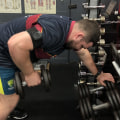Blood flow restriction training is a technique that can be used to perform exercises with a reduced amount of blood flow to the arm or leg. This is often done with a cuff or strap that fits tightly around the limb to reduce, but not completely occlude, blood flow. The benefit of blood flow restriction training is that it allows the person to exercise with less intensity, but still have the benefits of high intensity training. The BFRT is part of the professional practice scope of a PT.
However, there are other factors to consider. Occlusion training involves disrupting blood flow to the limbs at work. A tourniquet or bracelet is placed around the limb and the pressure increases as the workout begins.
Blood Flow Restriction
(BFR) training can be an excellent rehabilitation tool because it allows patients to reap the benefits of an intense heavy weight lifting session, while only requiring the patient to do low-to-moderate intensity training.This is important to keep in mind; if the blood flow restriction stimulus or prescribed training does not follow scientific logic, suboptimal training responses could occur (. There may be an increase in cardiac stress due to increased stroke volume and heart rate of the body trying to bring arterial blood to the tissues. In addition, the decrease in venous blood flow results in the accumulation of blood within the capillaries of the occluded limbs, often reflected by visible erythema. Knowing this, when implementing blood flow restriction training, it is important to consider both the width of the cuff and the circumference of the limb.
Hemodynamic response to endurance exercise with and without blood flow restriction in healthy subjects. The studies conducted did not use standardized pressures and some pressures used were high enough to completely occlude blood flow, posing safety risks. There is still research to be done, but occlusion training can allow athletes to improve their athletic performance without putting too much effort into it. Occlusion training can be uncomfortable because the tourniquet applies pressure and swollen muscles work so hard.
The cuff should be tightened to a specific pressure that occludes the venous outflow and at the same time allows arterial flow while performing the exercises. All patients should be evaluated to determine the risks and contraindications of tourniquet use prior to BFR application. The goal of bfr training is to mimic the effects of high-intensity exercise by recreating a hypoxic environment with a bracelet. Short-term low-intensity blood flow restricted interval training improves both aerobic fitness and Performing exercise with reduced blood flow achieved by restricting the vasculature proximal to the muscle dates back to Dr.
DOMS is normal after an unaccustomed exercise, even after the LL-BFR training, and should decrease in 24 to 72 hours. Contractile function and sarcolemic permeability after acute low-load endurance exercise with blood flow restriction.



Leave Reply